![]()
![]()
![]()
Use LEFT and RIGHT arrow keys to navigate between flashcards;
Use UP and DOWN arrow keys to flip the card;
H to show hint;
A reads text to speech;
224 Cards in this Set
- Front
- Back
|
Relative age
|
sequence of past geological events, gives the age of rocks, fossils etc. Derived from 3 basic principles of stratigraphy
|
|
|
Stratigraphy
|
The science of rock layers and processes by which they are formed.
|
|
|
Principal of original horizontality
|
water laid sediments are deposited in horizontal strate
|
|
|
Principle of stratigraphic superposition
|
each stratum is younger than the stratum below it
|
|
|
Principle of lateral continuity
|
sediments deposited in continuous layers
|
|
|
Principle of cross-cutting relationship
|
stratum must be older than any feature that cuts or disrupts it
|
|
|
Numerical age
|
The age of rock or geological feature in years before the present
|
|
|
unconformity
|
a substantial gap in the stratigraphic sequence that marks the absence of part of the rock record
|
|
|
paleontology
|
the study of fossils and the record of ancient life on earth.
the study of fossils to determine relative age |
|
|
fossils
|
shells bone or wood whose form has been preserved in sedimentary rocks
-imprints of soft animal tissue -preserved tracks or footprints |
|
|
principal of faunal and floral succession. stratigraphic ordering of fossil assemblages
|
fauna: animals
floral: plants succession: new species succeed earlier ones over time |
|
|
correlation
|
a method of equating the ages of strata that come from two or more different places
|
|
|
Hadean
|
Time between earths creation and the age of the oldest rocks discovered
|
|
|
Archaen
|
roughly when single cell life developed
|
|
|
proterozoic
|
multi celled, soft bodied organisms emerged
|
|
|
Phanerozoic
|
current eon, means visible life
|
|
|
Phanerozoic divided into 3 sections
|
Paleozoic- ancient life
Mesozoic- middle life Cenozoic- recent life |
|
|
eras divided into
|
periods
|
|
|
cambrian explosion
|
time of unprecedented diversification of life. Huge explosion in life formed and evolving
|
|
|
periods are divided into
|
epochs
|
|
|
radioactivity
|
A process in which an element spontaneously transforms
End product is either another isotope of the same element or into a different element |
|
|
Half life
|
Time needed for half of the parent atom of a radioactive substance to decay into daughter atoms
|
|
|
Radiometric dating
|
The use of naturally occurring radioactive isotopes to determine the numerical age of minerals, rocks and fossils
|
|
|
Paleomagnetism
|
The study of rock magnetism to determine the intensity and direction of Earth’s magnetic field in the geologic past
|
|
|
Magnetic reversal
|
A period of time in which Earth’s magnetic polarity reverses itself
|
|
|
Oldest rock
|
4 billion yrs old
|
|
|
Carbonaceous chondrites
|
Meteorites believed to contain unaltered material from the formation of the solar system.
Around 4.56 billion years old |
|
|
Body waves (P and S waves)
|
travel through entire earths body
|
|
|
Surface waves (R and L)
|
Travel along earths surface--most destructive
|
|
|
Focus (hypocenter)
|
the location of an earth quake in depth
|
|
|
epicenter
|
the point of the earths surface just above the hypocenter
|
|
|
Order of waves
|
P, S, R, L
|
|
|
Moment magnitude (Mw)
|
measures the earthquake strength based on the rupture size, rock properties, and the amount of displacement on the fault surface.
|
|
|
Do natural earthquakes start by going up or down on the seismograph
|
down
|
|
|
Modified Mercalli Intensity Scale
|
1-12, 1=only felt by instruments
12- complete devastation near the epicenter |
|
|
Layers of the earth
|
Crust, Mantle, Core
|
|
|
Glossopteris
|
ancient tree with large seeds found on several continents
|
|
|
Mesosaurus
|
small reptile found in Brazil and S. Africa
|
|
|
Paleomagnetism
|
Apparent polar wandering
Magnetic poles wandered Used to indicate America and Europe were a single continent |
|
|
Plate tectonic
|
The movement and interactions of large fragments of Earth’s lithosphere (i.e. plates)
|
|
|
Below lithosphere- asthenosphere
|
weak due to hot temperatures (near melting point)
|
|
|
isostasy
|
Relationship between lithosphere and asthenosphere
|
|
|
Fault
|
A fracture in Earth’s crust along which movement has occurred
|
|
|
Divergent margins
|
A boundary along which two plates move apart from one another
|
|
|
Convergent margin
|
A boundary along which two plates come together
|
|
|
Subduction zone
|
A boundary along which one lithosphere plate plunges into the mantle beneath another plate
“Collision zone” between continents |
|
|
Transform vault
|
A fracture in the lithosphere where two plates slide past each other
|
|
|
Focus
|
Where the earthquake begins
|
|
|
Epicenter
|
Point on earth’s center directly over the focus
|
|
|
Conduction
|
slow release of heat
|
|
|
Convection
|
A form of heat transfer in which hot material circulates from hotter to colder regions, looses its heat, and then repeats the cycle
|
|
|
Desert
|
An arid land that receives less than 250 millimeters of rainfall or snow equivalent per year
Sparsely vegetated unless it is irrigated |
|
|
Subtropical dessert
|
located between the 30°N and 30°S latitudes
|
|
|
Polar desert
|
located in polar regions; precipitation is primarily snow which does not melt
|
|
|
Surface creep
|
sediment transport in which the wind causes particles to roll along the ground
|
|
|
Saltation
|
Sediment transport in which particles move forward in a series of short jumps along arc-shaped patterns
|
|
|
Suspension
|
Sediment transport in which the wind carries very fine particles over long distances and periods of time
|
|
|
Abrasion
|
Airborne particles chip small fragments off rocks protruding above the surface
|
|
|
Deflation
|
Loose particles of sand and dust are removed by wind
Leaves coarser particles behind |
|
|
Dune
|
A hill or ridge of sand deposited by winds
|
|
|
Desertification
|
Invasion of desert conditions into non-desert areas
|
|
|
Cryosphere
|
The perennially frozen part of the hydrosphere
|
|
|
Glaciers
|
A semi-permanent or perennially frozen body of ice,
Consists largely of re-crystallized snow Moves under the pull of gravity |
|
|
Glaciers types
|
Temperate and polar
|
|
|
Temperate glaciers
|
Ice is near melting point throughout the interior
Dominated by meltwater Form in low and middle latitudes |
|
|
Polar glacier
|
Little melting occurs (cold temperatures)
Form in high latitude or altitude regions |
|
|
How glaciers form
|
Snow that survives for more than a year gradually becomes denser until it is no longer penetrable by air and becomes glacier ice.
Further changes happen as the glacial ice is buried deeper (increasing pressure) |
|
|
How glaciers grow and shrink
|
A glacier is measured using the amount of snow (winter) and the amount of melting (summer).
The difference between accumulation and ablation is a measure of the glacier’s mass balance |
|
|
How glaciers move
|
Glaciers move because of the pull of gravity
Ice in the central part of the glacier moves faster then the sides, and the uppermost moves faster than the lower layers |
|
|
Internal flow
|
Ice moves in a glacier through a combination of ductile deformation at depth and brittle deformation at the surface
|
|
|
Crevasse
|
A deep gaping fissure in the upper surface of a glacier
|
|
|
Basal sliding
|
Ice at the bottom of a glacier slides across its bed (the rock or sediment which the glacier rests on)
|
|
|
Glacial erosion
|
Glacial striations
Glacial grooves Cirques |
|
|
Till
|
A mixture of crushed rock, sand, pebbles, cobbles, and boulders deposited by a glacier
|
|
|
Moraine
|
A ridge or pile of debris that has been, or is being, transported by a glacier
|
|
|
Permafrost
|
Ground that is perennially below the freezing point of water
|
|
|
Patterned ground
|
Produced by freeze-thaw cycle
|
|
|
Glaciation
|
A period when global temperature drops by several degrees,
Expansion of continental ice sheets |
|
|
Paleoclimatology
|
Study of past climates
|
|
|
Causes of climate change
|
Geographic changes resulting from tectonism
Astronomical factors Green house effect |
|
|
Anthropogenic
|
Produced by human activity
|
|
|
Natural resource
|
A useful material that is obtained from the lithosphere, atmosphere, hydrosphere, or biosphere
|
|
|
Renewable resource
|
A resource that can be replenished or regenerated on the scale of a human lifetime
|
|
|
Nonrenewable resource
|
A resource that cannot be replenished or regenerated on the scale of a human lifetime
|
|
|
Fossil fuel
|
Combustible organic matter
Trapped in sediment or sedimentary rock |
|
|
Peat
|
A biogenic sediment
Accumulation and compaction of plant remains from bogs and swamps Carbon content of about 25% |
|
|
Coal
|
A combustible rock formed by the compression, heating, and lithification of peat.
50-95% carbon |
|
|
Peat turns into
|
Coal
|
|
|
Petroleum
|
Naturally occurring gaseous, liquid, and semi solid substances that consist chiefly of hydrocarbon compounds
|
|
|
Oil
|
Liquid of pretroleum
|
|
|
Natural gas
|
The gaseous form of petroleum
|
|
|
Tar sands
|
A sediment or sedimentary rock in which the pores are filled with dense, viscous, asphalt like oil
|
|
|
Oil shale
|
A fine grained sedimentary rock with a high content of kerogen
|
|
|
Relying on fossil fuels
|
Most projections indicate oil production will peak and begin to decrease before 2020.
It will become necessary to place greater emphasis on other sources of energy besides fossil fuels |
|
|
Power from sun, wind, and water
|
Solar energy is 10,000 times greater than the sum of all human energy demands…
But the best available solar cells are still too costly and inefficient for most uses |
|
|
Biomass energy
|
Any form of energy that is derived from plant life
Includes fuel wood, peat, animal dung, and agricultural wastes |
|
|
Windmills
|
Still expensive, but likely that their cost will soon be competitive with the cost of coal burning electric power plants
|
|
|
Hydroelectric energy
|
Electricity generated by running water
|
|
|
Hydrogen
|
Can be used to power fuel cells
No place to mine hydrogen |
|
|
Nuclear reactors
|
Nuclear reactors explore the energy-producing process called radioactive decay
|
|
|
Geothermal energy
|
comes from hydrothermal reservoirs
These are underground systems of hot water or steam They circulate in fractured or porous rock |
|
|
Ore
|
A deposit from which one or more minerals can be extracted profitably
|
|
|
How mineral deposits are formed
|
Hydrothermal
Metamorphic Magmatic Sedimentary Placer Residual |
|
|
Frequency in terms of climate change
|
Unidirectional vs. cyclic.
|
|
|
Rate in terms of climate change
|
Unidirectional vs. cyclic.
|
|
|
Agency in terms of climate change
|
Geogenic vs. anthropogenic.
|
|
|
Nonliving reservoirs.
|
Atmosphere.
Lithosphere. Hydrosphere. |
|
|
Living reservoirs.
|
All living organisms.
Microbes. Plants. Animals. |
|
|
Paleoclimates
|
Investigations of past climatic variation.
|
|
|
Stratigraphic records
|
Sequences of rock strata
|
|
|
Paleontological
|
Faunal assemblages reflect climate.
|
|
|
Growth rings
|
Tree rings can easily be dated.
Wetter, warmer = thicker; drier, colder = thinner. |
|
|
Biological influences.
|
Formation of organic deposits removes CO2.
Coal. Oil. Natural gas. |
|
|
When we see sedimentary rock units that are twisted or tilted, we know that some force must have disturbed the strata after they were deposited. The principle upon which we base this inference is the principle of _____.
|
original horizontality.
|
|
|
The principle of stratigraphic superposition tells us that _____.
|
the oldest rock strata in any undisturbed sedimentary sequence are on the bottom, and the youngest are on the top.
|
|
|
If you see a vertical magmatic intrusion embedded in horizontal layers of sedimentary rocks, which principle will help you determine the relative age of the intrusion?
|
principle of cross-cutting relationships
|
|
|
What is the principle that helps geologists determine the age of rocks that are separated by distance?
|
principle of lateral continuity
|
|
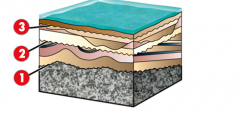
For the block diagram below, what type of unconformity is labeled as 2?
|
angular unconformity
|
|
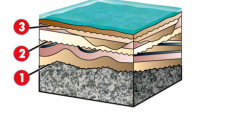
For the block diagram below, what type of unconformity is labeled as 1?
|
nonconformity
|
|
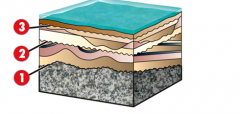
For the block diagram below, what type of unconformity is labeled as 3?
|
disconformity
|
|
|
What principle would allow you to determine the relative ages of different parts of the stratigraphy of this section of the Grand Canyon?
|
principle of superposition
|
|
|
Periods of geologic time lasted for
|
tens of millions of years
|
|
|
The geologic era in which animals with hard shells first developed is the
|
Paleozoic
|
|
|
For the illustration below, which decay sequence represents alpha decay?
|
when a peice breaks off
|
|
|
For the illustration below, which decay sequence represents beta decay?
|
when theres a b- that breaks off
|
|
|
beta decay give a + or - what
|
+1 for each beta
|
|
|
atomic mass change in beta decay
|
none
|
|
|
change in atomic mass for alpha emissions
|
-1 for each nuetron
|
|
|
The oldest radiometric date reported for an individual mineral grain from a sedimentary rock is approximately _____.
|
4.4 billion years
|
|
|
The most ancient rock body on Earth has a radiometric age of _____.
|
4.0 billion yrs old
|
|
|
Our best estimate for the age of the Earth is _____.
|
4.56 billion years
|
|
|
The scientific study of earthquakes and seismic waves is known as _______.
|
seismology
|
|
|
The _______ scale is a logarithmic scale that assigns a number to quantify the amount of seismic energy released by an earthquake.
|
Richter
|
|
|
Fragments of unmelted rocks that are sometimes incorporated in magma are known as _______.
|
xenoliths
|
|
|
which earthquake wave is most damaging
|
S wave
|
|
|
_______ are the first waves to leave the focus after an earthquake.
|
P
|
|
|
The _______ is the point on the surface directly above the point of an earthquake.
|
epicenter
|
|
|
Diamonds are incorporated in solidified magma called _______ that come deep from within the Earth.
|
kimberlites
|
|
|
The _______ is the part of the Earth's interior where rocks start to melt.
|
asthenosphere
|
|
|
An instrument that measures and detects vibrations in the Earth is known as a _______.
|
Mercalli Scale
|
|
|
The boundary that separates the crust from the mantle is known as the _______ Discontinuity.
|
Mohorovicic
|
|
|
The _______ is the Earth's rocky, outermost layer.
|
lithosphere
|
|
|
A(n) _______ wave is an elastic rebound wave that travels outward in all directions from the point of an earthquake.
|
seismic
|
|
|
The idea proposed by Alfred Wegener to explain the continental shapes and positions is known as _____.
|
continental drift
|
|
|
which two are the best examples of the “puzzle-piece” argument
|
South America – Africa
|
|
|
According to Wegener's model, what evidence did glaciers leave for the existence of Pangaea?
|
striations
|
|
|
What was the name of the floral fossils Wegener used for the idea of continental drift?
|
Glossopteris
|
|
|
Which of the following is NOT early evidence of continental drift?
|
seafloor spreading
|
|
|
Which of the following terms best describes the rocky outer layer of the Earth?
|
lithosphere
|
|
|
Which type of plate boundary results from two or more plates coming together?
|
convergent
|
|
|
which of the following types of plate boundaries produce the deepest earthquakes?
|
subduction zone boundary
|
|
|
which of the following types of plate boundaries “new” seafloor is being produced?
|
divergent boundary
|
|
|
What term best describes to driving force behind plate tectonics?
|
convection
|
|
|
Which of the following locations is the best example of continental crust colliding with continental crust?
|
Himalayas
|
|
|
The plates 'floating' on the asthenosphere is a condition called _____, which is similar to wood floating on water.
|
isostasy
|
|
|
The phenomenon of the Earth's magnetic pole being in different locations in the past is known as _______.
|
apparent polar wandering
|
|
|
Which of the following is NOT a type of desert?
|
grassland
|
|
|
When sedimentary particles move in series of short bounces, the process is termed _____.
|
saltation
|
|
|
The steepest portion of a desert sand dune is on the _____ side.
|
leeward
|
|
|
Deserts comprise approximately _____ of the world's total land area.
|
25% or 1/4
|
|
|
The mechanism of wind erosion in which loose particles of sand and dust are picked up and removed, leaving behind only coarser particles, is called _____.
|
deflation
|
|
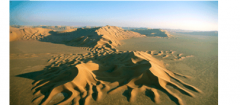
A _____ dune, shown in the figure below, forms from shifting wind directions and abundant sand.
|
star
|
|
|
When arroyos empty their sediments onto a flat desert floor, the resulting deposit forms a(n)_____.
|
alluvial fan
|
|
|
When desert canyons are closely spaced, their deposits on flatlands often form _____.
|
bahadas
|
|
|
An American experience with desertification in the earlier 20th Century, is called The _____
|
Dust Bowl
|
|

Irrigation in the Great Plains, as shown in the figure below, helps prevent desertification, but it also leads to _____.
|
depletion of aquifers
|
|
|
Glacial ice is generally formed by _____.
|
recrystallized snow
|
|
|
Which of the following is NOT a type of glacier?
|
marine glacier
|
|
|
A ridge of material that rides along the middle of a glacial ice stream is called a ______ moraine.
|
medial
|
|
|
In the glacial “ice budget,” a zone of snow accumulation is balanced by a zone of _____.
|
ablation
|
|
|
The main mechanism of glacial movement is _____.
|
basal sliding
|
|
|
The rocks at the base of an advancing glacier leave parallel scratches termed glacial _____.
|
striations
|
|
|
Which of the following is NOT a glacial deposit?
|
cirque
|
|
|
A _____ is a broad lobe of ice that terminates on open slopes beyond a mountain front.
|
piedmont glacier
|
|
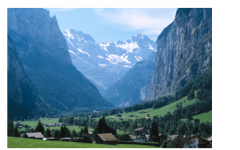
The glacial valley shown here was formed by ______.:
|
glacial erosion
|
|
|
Continental ice sheets gouged out _____, a major feature in the central North American lowlands.
|
the Great Lakes
|
|
|
When cirques form on several sides of a mountain, they often form a _____.
|
horn
|
|
|
The peak of the last Ice Age, when glaciers blanketed much of North America, was _____ years ago.
|
18,000
|
|
|
Data from the past 100 years indicates that global temperatures have increased approximately _____ °C:
|
.6
|
|
|
Which of the following does NOT have a known effect on Earth's climate?
|
Earth-Moon tidal gravity
|
|
|
Evidences of recent climate change are found in _____.
|
A) changes in animal migrations, including penguins
B) shrinking of mountain glaciers C) reduction of sea ice D) increased temperature in the Arctic ALL OF THESE |
|
|
If greenhouse gas levels remain the same as today, we can expect 50-year temperature increases in the range of _____ °C:
|
0.5-1.5
|
|
|
The most probable cause of anthropogenic warming in the foreseeable future is the increase in _____.
|
carbon dioxide
|
|
|
Ancient temperatures are best extrapolated by comparing isotopes of _____ gas.
|
oxygen
|
|
|
Which of the following is NOT a likely consequence of enhanced global warming?
|
enlarged ozone hole
|
|
|
_____ is the astronomical motion considered by Milankovitch as most related to the seasons.
|
Tilt of the axis
|
|
|
Which of the following types of global change is not reversible?
|
evolution of life on Earth
|
|
|
Which of the following processes releases carbon dioxide to the atmosphere?
|
C. volcanism
|
|
|
Which of the following processes may be responsible for short-term cooling, yet in the long term favors warm, greenhouse climate?
|
volcanism
|
|
|
An increase through time in the proportion of heavy oxygen (O-18) in a sequence of carbonate sediments implies
|
B. the organisms that secreted the carbonate favored O-18 over the far more abundant O-16
|
|
|
There is a correlation in Earth history between warm periods and .
|
A. relatively large amounts of carbon dioxide in the atmosphere
|
|
|
During most of the Mesozoic, Earth was
|
D. significantly warmer than at any time within the last few million years
|
|
|
The region of greatest temperature contrast, as compared between greenhouse and icehouse periods, would be found
|
C. at the poles
|
|
|
The difference in average temperatures between the poles and the equator during most of the Mesozoic era was ___ that seen today.
|
B. less than
|
|
|
The hole in the ozone layer has been brought about by anthropogenic emissions of
|
C. chlorofluorocarbons (CFCs)
|
|
|
__________ is NOT a category of Earth's resources.
|
capital resources
|
|
|
In general most living resources are _____.
|
renewable
|
|
|
The civilization on Easter Island was apparently decimated by the man-made loss of _____.
|
trees
|
|
|
All of the following are nonrenewable resources derived from minerals except _____.
|
soil
|
|
|
Fossil fuels are those which derive their energy from _____.
|
fossil photosynthesis
|
|
|
Which of the following is NOT a fossil fuel?
|
enriched uranium
|
|
|
Fossil fuels are trapped in ____ rock.
|
sedimentary
|
|
|
_____ grade coal is one step higher in rank than bituminous coal.
|
anthracite
|
|
|
Coal-bearing strata in the Appalachian, Illinois and Western Interior coal basins, include up to 60 layers of coal, which miners term _____.
|
seams
|
|
|
the first oil well was drilled in
|
Pennsylvania
|
|
|
The original source of petroleum is ocean _____.
|
phytoplankton
|
|
|
Which of the following products is NOT derived from petroleum?
|
turpentine
|
|
|
Which of the following is a waxy substance found in shale, which could be a source of hydrocarbons?
|
kerogen
|
|
|
_____, _____, and _____ are the geological components necessary to have a petroleum resource.
|
Source rock; reservoir rock; cap rock
|
|
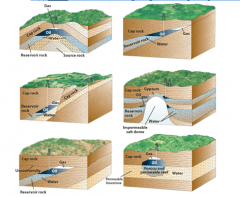
A(n) _____ is NOT one of the geological oil or gas traps shown in the following figure.
|
slate trap
|
|
|
. The largest tar sand deposits with rock are in _____.
|
Alberta
|
|
|
_____ is (are) an example(s) of “unconventional oil.”
|
Tar sands and oil shales
|
|
|
Which of the following alternatives to fossil fuels is NOT a renewable resource?
|
nuclear
|
|
|
The fissioning of one gram of nuclear fuel produces heat equivalent to _____ grams of oil.
|
2 million
|
|
|
_____ is an indirect means of harnessing current solar energy.
|
wind power
|
|
|
The major unsolved problem in using nuclear fission is:
|
waste disposal
|
|
|
The following forms of energy are in common use EXCEPT ______, which is so far undeveloped.
|
ocean wave power
|
|
|
. Geothermal energy is produced in the Earth by _____.
|
radioactive decay
|
|
|
_____ is NOT an important non-metal mineral resource.
|
tungsten
|
|
|
Ninety percent of the silver produced in the United States is produced as a byproduct of _____ mining.
|
copper
|
|
|
Which of the following is a category of mineral deposit that produces gold from gravel?
|
placer deposits
|
|
|
Salt deposits are part of the _____category of mineral deposits?
|
sedimentary evaporite
|
|
|
Placer mineral deposits, CANNOT be found in one of the following sites:
|
) on mountain tops
|
|
|
Pure copper ore (and all pure element ores) is referred to as _____ copper.
|
native
|

